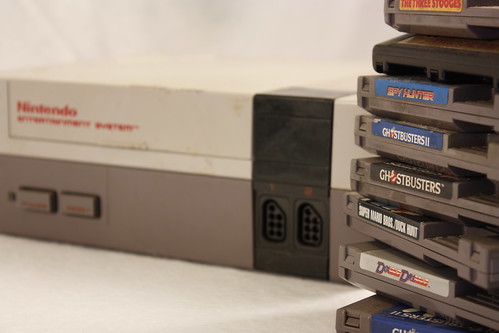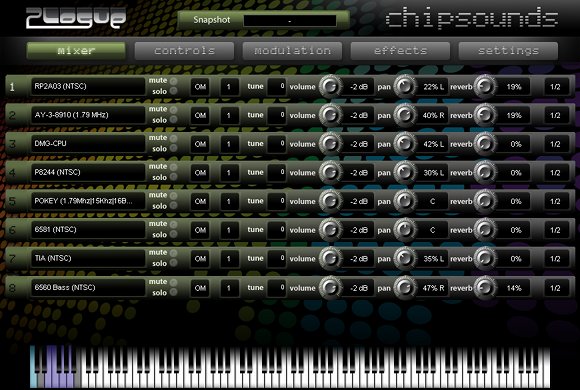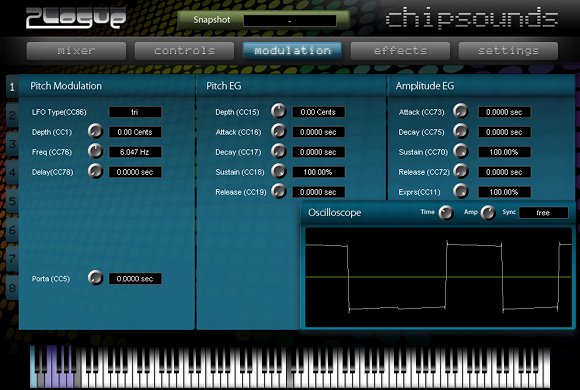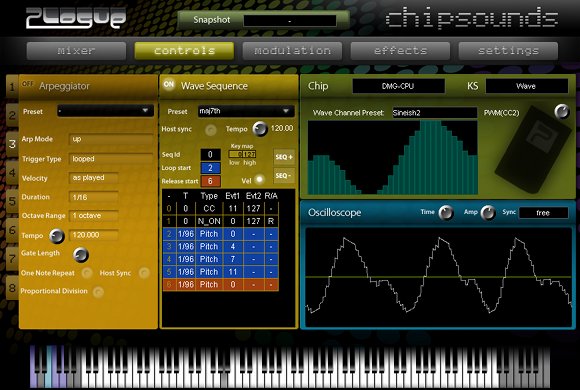Call it the 8-bit preservation society. Chipsounds is now available. It’s a new programmable soft synth, filled with custom oscillators and samples of famous and obscure vintage chips, accompanied by an EP of free chip tracks. Far from a threat to fans of hardware, I think this release is a major achievement for fans of digital sounds.
Oh yeah, and if you’ve been feeling burnt out on chip music in general, firing up some of the sound of some of these more obscure chips could well change your mind. If you like sound, there’s something here for you.
Chip music, championed by a supportive network of artists and fans, has unquestionably made the big time. But for those who value the unique sounds of a variety of vintage 8-bit chips, there is still cause for concern. Even though they’re digital circuits, the unique design of various chips won’t last forever. Some chips are simply disappearing, while others cease to work. At the same time, while the sound of the Nintendo game system has become ubiquitous, lots of other unusual chips don’t get heard. Software emulation and sample packs so far have been pretty shallow. Emulators tend not to model all the nuances of different chips, and samples are really only expressive if they’re presented in the context of something that’s fully programmable and playable.
Enter Chipsounds. Creator David Viens told us about the Chipsounds project back in January:
Authentic Chipmusic Soft Synth Emulation: Plogue Chipsounds Scoop from NAMM
It’s available today, with an introductory price of US$75 ($95 thereafter).
chipsounds @ Plogue [Product Page]
Something like Chipsounds could have been just an attempt to cash in on “what the kids are playing.” But David’s work is more like an epic love poem to the sounds of chips themselves, not only as a reminder of game music but as a unique sound source. And the passionate chip music community got in on the act, as well, with notable artists contributing to the product’s development and in fine form on the EP.
But forget about that for a second. What matters is that chipsounds is an exhaustive, exhaustively programmable set of sounds that almost no eBay budget could ever amass. It takes some unique sounds and allows you to warp them into arrangements and performance configurations not possible with hardware. And it might well make you explore hardware in a new way all over again.
For your listening pleasure, here is the full, free EP with downloadable tracks to set the mood. It’s all been made with Chipsounds by some terrific artists, including David Viens himself, and covers a range of genres and techniques.
Why Chipsounds
David has a really lovely intro in the manual for the tool. He’s got a story like many of us I expect have.
My father bought a Commodore VIC-20 for me and my brother when I was around nine. After a few days with it, I guess he knew I had found my calling. There is not a year that passes without me reminding him how bringing that computer home some cold autumn night changed my life.
But this isn’t just nostalgia. David also notes that some of the limitations imposed by earlier 8-bit hardware caused artists and musicians to invent new techniques that were later lost. These methods can now be rediscovered and coexist with new processes only possible with newer tech. What Chipsounds represents is an expanded “sonic palette,” not just the literal representation of the hardware included. And for those willing to dig into programming the sampling instrument itself, that palette can be even wider and more personal.
David did a whole lot of work on research and experimentation to make this work, but also drew upon the massive community online. Here’s a look at the chips included.
The Instruments
David did extensive research, testing, sampling, and A/B sound programming for the project. Just going through the chips is a nice history lesson – and could be a good introduction for those interested in working with hardware, too. You can check out extensive technical details on the hardware at the chipsounds blog.
SID (6581) and (8580) It’s the mother of all sound chips, and deserves the top space in this list. The SID was the legendary Commodore 64 chip, sampled in this collection at 96KHz. The 8580 I think doesn’t get nearly enough credit, so it’s nice to see both so you can hear the oddities of each.
RP2A03 (NTSC) and RP2A07 (PAL) and RP2A0X (unlimited): This is the big one – the chip in Nintendo’s NES and Famicom. It’s not actually a dedicated audio IC, but a clone of the 6502 CPU, but it still has some unique features and sounds.
DMG-CPU, SGB and DMG(unlimited) The classic: Nintendo’s own sound generator for its Game Boy handheld. Confession time: I’ve heard this chip so much that I’m starting to long for other things. But again, because the Chipsounds collection lets you create hybrid instruments in different ranges, there’s nothing stopping you from inserting DMG sounds where you wouldn’t expect. (And while functioning Game Boys are everywhere and run a variety of amazing homebrewed sequencing software, some of these other chips aren’t as accessible or portable.)
AY-3-8910 (various clocks sources), YM2149 (2Mhz): General Instruments’ sound chip was one of the great sound chips of the 8-bit gaming and computing age, found in the Intellivision, Vectrex, Atari ST, and Sinclair ZX, among many others. That means it’s critical not only to gaming fans, but also fans of the sounds in early tracking musicians, particularly on the Atari ST. It’s even got its own Wikipedia article.
D1867G The classic Casio VL-1 makes a surprise cameo in this collection. Result: you have the opportunity to imagine your own music console that combines the sounds of the VL-Tone with the IBM PCjr, and that’s a beautiful thing. The VL-1 may be the odd man out in this collection, but then, it also exemplifies the lo-fi digital sound of the 80s – and with the ARIA sampling engine, you can warp it to do things it has never done before.
P8244 (NTSC), P8245 (PAL) This is one of the rarer (or at least more unexpected) entries in the collection, the sound chip that drove the Magnavox Odyssey2. Intel’s Video Display Controller used this chip to make both graphics and sound (hmmm… could Chipgraphics be next?) For extreme nerding out, check out David’s full post on working with this chip. Unlike the other entries here, the VDC doesn’t have much documentation online for these kinds of applications.
POKEY (various clock configuration) Atari’s Doug Neubauer created sound capabilities for this chip, used in Atari’s 8-bit computers as well as many arcade games. (The POKEY actually handled not only audio, but keyboard, pots, timing, serial… Arduino fans, take note.) Which arcade games? Try Tempest, Gravitar, Gauntlet and Crystal Castles, for starters.
TIA (NTSC), TIA (PAL) and TIA (unlimited) Another combined graphics and sound chip, the Television Interface Adapter was the sonic soul of the Atari 2600. The variations here in Chipsounds give you a lot of choices, including the awesome “polynomial counters” which create different kinds of distortion. Using keyswitching, you can choose among these sounds live, ideal for keyboardists. And David has even included the sounds the TIA makes when the cartridge was improperly inserted.
SN76489(AN) (various clocks) Here’s my personal favorite: the classic Texas Instruments sound chip was dead-simple (three square wave generators and one white noise generator), but elegant, efficient, and unique in sound. The BBC Micro, IBM PCjr, and ColecoVision game system all used its sounds. I can still hear the echoes of Subroc in my sleep. (Yeah, okay, I was a bit jealous of my friends who had Apple IIs and NES instead of the more oddball PCjr and Coleco I had, but now I’m older and appreciate them more.)
Side note: David was nice enough to share some of his SN chips, so I’m working on building them into standalone hardware and will share the results.
UVI 2637(NTSC) and 2637(PAL): Now we get into the chips you probably haven’t heard. Signetics made this chip for the Arcadia 2001 console developed by Emerson (yeah, the electronics company) in the heady year of 1982, before the meltdown that would purge the home gaming market. That console was widely cloned, under names like the Interton, Leisure Vision, and MPT-03.
VIC-I : 6560 (NTSC) 6561(PAL) in various configuration Here’s another oddball chip: the VIC-I, used in the VIC-20, had 7-bit pitch range, giving you oddly-tuned scales, plus a truly strange noise generator. That strange sound is rarely heard, but leave it to the demoscene to exploit it. From the Chipsounds manual:
In 2003, a brilliant demo writer by the name of Viznut reverse-engineered this side effect, mapping all possible “weird” waveforms that the chip was able to reproduce in a deterministic manner, and put the to good use in his now famous “Robotic Liberation” demo.
Here’s a look at that creation:
The Software
Let’s get something out of the way: I believe in synths. I’m naturally skeptical of samples. If I believed for a second Chipsounds was about plugging in some sampled sounds and hitting a key and waiting, I wouldn’t have posted this article. Fortunately, Plogue’s ARIA sampling-plus-synthesis engine is powerful enough to allow immense programmability and playability. It’s loaded up with programs that model every last detail of these instruments, while also providing the possibility to create your own, unique performance configurations. Samples make up just a portion of the sound, used where appropriate, with lots of custom oscillators and modulators, as well. This is really a full-blown instrument, not just a sample library. (ARIA has previously been sampling-only, but Chipsounds is the first of a line of instruments to use synthesis, as well.)
Standalone, plug-in modes:
As a plug-in, Chipsounds works with VST on Mac and Windows, RTAS (for Pro Tools) on Mac and Windows, and Audio Units on Mac. And of course, in plug-in mode you can automate all your parameters.
In standalone mode, you have additional features: audio file recording, MIDI file playback, and even the ability to render MIDI to audio directly.
Mixing, Multis:
- Load up to eight chips/instruments per instance. (Each of those, in turn, can be made up of combinations of samples.) Maximum polyphony is suggested at about 4-5 voices for artistic reasons, but… rules are made to be broken, right?
- Assignable tuning, polyphony, mix parameters
- Reverb busing
- Key switching, which allows you to change between waveforms immediately using a key on your keyboard
- Snapshots
Sound editing:
Here’s where things get fun – and where you can do things more easily than you could with the original hardware. Even with the ARIA engine alone, you have a virtual studio of tools in which to place your samples.
- Arpeggiator for pitch, velocity: with configurable range, loop modes, gate, sync, etc.
- Wave sequencer: This allows you to sequence lists of pitches on an instrument, allowing tracker-style events inside the software. (Add your own tracker to the mix and – well, things get pretty hectic.)
- Live, high-performance oscilloscope.
- Pitch LFO (currently fixed), pitch and amplitude envelope generators.
- Effects, which currently includes only an ARIA-native port of the lovely Ambience reverb by Magnus Jonsson. (But then, the advantage of having these sounds on your computer is easy access to all your other effects.)
Still Want Hardware?
In order to make the Chipsounds collection, David spent time rigging quick hardware devices allowing the actual chips to be connected to a computer. That could make Chipsounds an affordable gateway drug into building your own standalone hardware with these chips as sound sources, as I hope to do soon with my TI SN’s. To get you started, check out the superb resources on the Midibox wiki:
Midibox SID
Midibox POKEY
MIDIbox AY 3 8912
The SID is the most common of these, but ironically finding working SIDs is getting to be much harder than finding these other unique, lovely chips.
I’m actually really interested in the possibilities of combining hardware with the open-source Arduino platform and creating devices that behave in new ways; stay tuned, and hopefully we can get a group of folks working on that.
One example – our friend little-scale aka Sebastian Tomczak of South Australia – has used the Arduino to connect to the SN chip and create a MIDI-controlled Sega Master System equivalent:
MIDI + Arduino + chip on little-scale’s blog
Add in new MIDI capabilities on the Arduino, and this gets quite interesting.
The Artists
A lovely collection of artists contributed to the EP and to the development of the software, so this is very much a release connected to the community. (David’s own music is on the EP, too.)
The artists:
8Bit Weapon
Computeher
nitro2k01
Chupathingy and on MySpace
James Mireau
XC3N
shrimps
And for more on the making of one of the tracks, GameBoy Genius aka nitro2k01 has documented the work of translating a hardcore chip track from Game Boy to computer, using Renoise. This is a pretty traditional approach to what to do with chip music, but on the other hand, once you’re in the world of Renoise, you could go in other directions, as well.
If you’re interested in anything covered here – the artists, the chips and digital synthesis history, how to use the software, or how to make some of these hardware creations – all of these topics are fair game for CDM. I promise a non-nostalgic (okay, maybe slightly nostalgic), musical approach to these topics.
In the meantime, let us know what you think of the software.
















